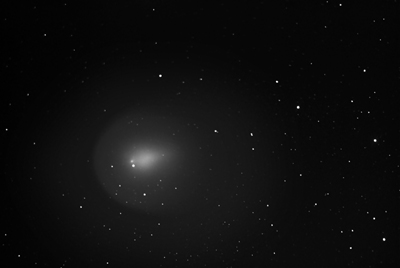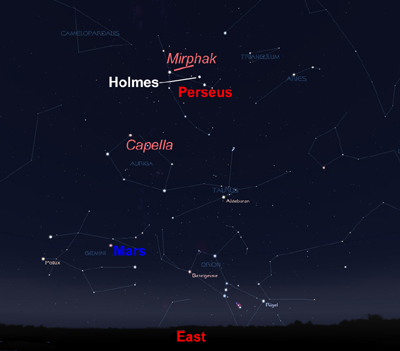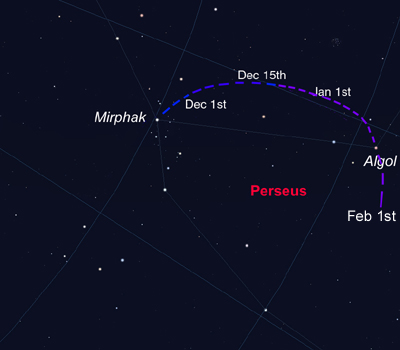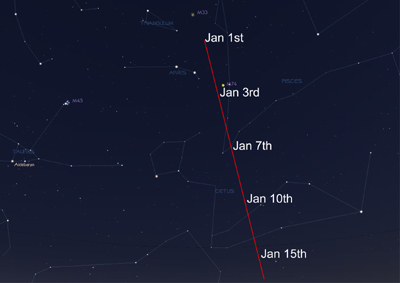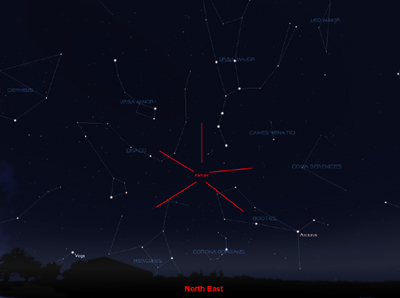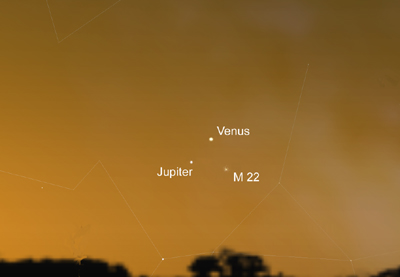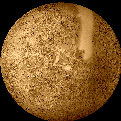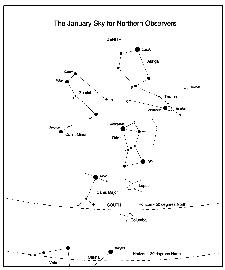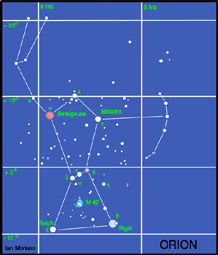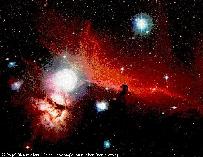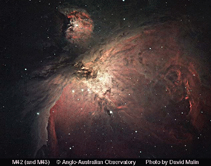The Night Sky January 2008
Compiled by Ian Morison
This page, updated monthly, will let you know some of the things that you can look out for in the night sky. It lists the phases of the Moon, where you will see the naked-eye planets and describes some of the prominent constellations in the night sky during the month.
Image of the Month
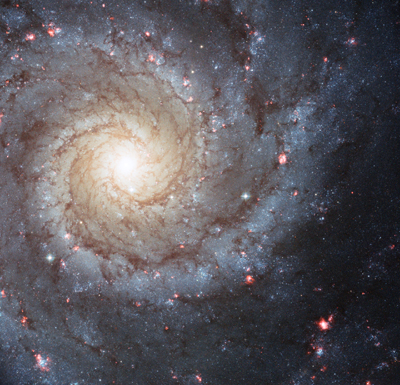
The spiral galaxy M74 in Pisces
Image: Hubble Heritage Team, NASA
This beautiful spiral galaxy lies about 32 million light years away beyond the constellation Pisces - see the highlight about comet 8P/Tuttle. Its spiral arms are sprinkled with open star clusters and the regions of star formation glow red with the light emitted by hydrogen excited by the ultra-violet light from young blue stars. It is a type Sc spiral with a relativly small nucleus and open spiral arms.
Highlights of the Month
January: the Comet 17P/Holmes
Click on to enlarge
I am writing this before Christmas and, as I write we can still observe Comet Holes in the sky - but sadly, no longer visible to the unaided eye. However it is still a very worthwhile object to observe with binoculars. The comet, P17/Holmes, which is ~ 240 million km from the Earth underwent a major outburst in late October and, for sometime, appeared at ~ Magnitude 3 as a new star in the constellation Perseus. To locate the comet in the evening sky - the chart below is for 10pm - first find the bright star Capella low in the east. Up and to the right is the slightly dimmer star Mirphak with the comet just up and to its right. A chart is given below to help you locate it. It moves towards the star Algol during December and January. Comet Holmes orbits the Sun every 6.88 years and was discovered by Edwin Holmes in November 1892. It was closest to the Sun in May this year but never gets closer than Mar's orbit. Try to observe it soon - it may not be visible for much longer! The tail is very short and is pointing away from us as the comet is nearly on the opposite side of us from the Sun.
First week January: Comet 8P/Tuttle
Click on to enlarge
Comet Tuttle passes within just 38 million kilometres on the evening of the 1st of January. This is pretty close and so it will be moving quite rapidly across the night sky. The peak magnitude will be about magnitude 5 so, with dark skies one might just see it with the unaided eye but binoculars may well be needed. From the 1st to the 4th it is running down the boundary between Aries and Pisces and, on the 3rd, lies just 3 degrees to the left of the spiral galaxy M74 in Pisces. It will be in the south as darkness falls. See the chart above to locate its position during the first two weeks of January. A New Moon on the 8th of January will help as the will be no moonlight in the evening sky until ~ 11th January.
January: Mars just past closest approach
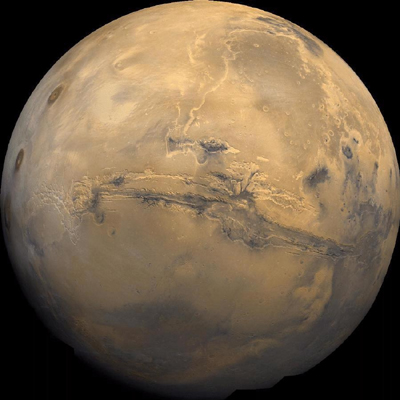
Mars as viewed by spacecraft showing Vallis Marineris (centre) and two of the giant volcanoes (upper left).
Mars at its best for several years
On the night of December 24th Mars was at opposition - that is it will opposite the position of the Sun in the Sky, and thus seen due south at midnight. This was also close to the time, on December 18th, when it was closest to us and hence its disk will be at its largest. In the first week of January it will still be brighter and appear larger in the sky than it will do for eight and a half years! At this opposition it reached just under 16 arc seconds - and will still have an angular size of 15.3 arc seconds at the beginning of January - so a small telescope will be able to detects features on the surface such as the polar caps and the dark region Syrtis Major - an excellent reason for purchasing a telescope!
However, as Mars's orbit is elliptical, the closest seperation varies from apparition to apparition. On August 27th 2003, the Earth and Mars were as close as they virtually ever get - at least for ~60,000 years, but it was nearly as close in August 13th 1766, August 18th 1845, and August 23rd in 1924. Notice that all these dates were in August. This is not a coincidence as this is when the Earth is at its furthest from the Sun. The closet of all approaches occur when the Earth is furthest from the Sun and Mars is closest to the Sun. At these closest of close approaches, the angular size of Mars reaches 25 arc seconds. This is obviously not the case this time as the Earth is closest to the Sun in the Winter. However, in contrast to 2003 when Mars was rather low in the Sky and the atmosphere hindered our view, Mars is now in Gemini, at almost the highest part of the ecliptic, so although its angular size will be smaller, our view may even be better!
Mars peaked in brightness in late December at magnitude -1.6 when it outshines the brightest star in the northern hemisphere, Sirius, at -1.4. At the end of December it passed just north of the star cluster M35 before passing into Taurus on the 30th December where it will remain throughout January as its brightness falls to -0.6 magnitudes.
January 4th after midnight: look out for the Quandrantid Meteor Shower - and observe Alcor and Mizar
The Quantrantids
The early morning of Jan 4th will give us the chance, if clear, of observing the Quandrantid meteor shower. The shower is expected to peak on the morning of the 4th of January at about 5 am. The radiant - where the meteors appear to come from - is in the constellation Bootes not far below the tail of Ursa Major, the Great Bear. Here there was once a small constellation named after the "Quadrant" which was the device used by early astronomers - most notably Tycho - to measure the elevation of stars as they crossed the meridian (an arc running from horizon, due south, up to the pole star). Given the time at which this happens, it is possible to measure the star's celestial co-ordinates. The peak hourly rate can reach 200, but they are not particularly bright so a good dark observing site will help observe them. Happily, this year, the Moon will be a thin waning crescent and should not impede our view Whilst observing this part of the sky look at the central star of the tail of the Great Bear. Binoculars will easily show that there are two stars - Mizar,the brighter and Alcor, the Horse and Rider. You may even spot this with your unaided eye. A small telescope will show that Mizar is a nice double star! If it is clear it will be cold - so wrap up well, wear a woolly hat and have some hot drinks with you!
January 31st: look out for the conjunction of Venus and Jupiter - and possibly spot the globular cluster M22.
Venus and Jupiter will be seen low in the eastern pre-dawn sky at the very end of January within one and a half degrees of each other. Venus will be the brighter at -4 magnitudes with Jupiter at -1.9. With binoculars you might also spot the globular cluster M22 - one of the brightest in the sky at magnitude 5.1. It, Jupiter and Venus will form a nice triangle.
Observe the International Space Station
Use the link below to find when the space station will be visible in the next few days. In general, the space station can be seen either in the hour or so before dawn or the hour or so after sunset - this is because it is dark and yet the Sun is not too far below the horizon so that it can light up the space station. As the orbit only just gets up the the latitude of the UK it will usually be seen to the south, and is only visible for a minute or so at each sighting. Note that as it is in low-earth orbit the sighting details vary quite considerably across the UK. The NASA website linked to below gives details for several cities in the UK. ( Across the world too for foreign visitors to this web page.)
Find details of sighting possibilities from your location from: Location Index
See where the space station is now: Current Position
The Moon

The passage of the Moon through the Earth's shadow March 2007: Cape Newwise 200 mm telescope and Nikon D80 camera.
Ian Morison, Jodrell Bank Observatory
| new | first quarter | full moon | last quarter |
|---|---|---|---|
| Jan 8th | Jan 15th | Jan 22th | Jan 30th |
Some Lunar Images by Ian Morison, Jodrell Bank Observatory: Lunar Images
The Planets
Jupiter
Jupiter passed behind the Sun (actually this may well have been precicely true - certainly according to my planitarium program) on the 23rd December, so will not be visible at the beginning of January.) However, as the month progresses it will rise earlier than the Sun and may be glimpsed in the pre-dawn sky below and to the left of Venus. By the end of the month it is 30 degrees from the Sun and just over one degree from Venus. It is in conjunction with Venus just one day later when it lies under half a degree away just below Venus. See also the highlight above.
Saturn
Saturn As January begins, Saturn lies just over 8 degrees down to the lower left of the star Regulus in Leo and rises at 21:30 UT. It starts the month at magnitude +0.6 with an angular size of 20 arc seconds. Saturn will not be as bright this coming year as it sometimes is: the rings are closing (just ~ 8 degrees tilt to us and subtending only 5 arc seconds) and thus there is less apparent reflecting area. the rings will be seen (or rather - not seen) edge on in 2009 and it will not be until 2016 that they will be at their widest again. A small telescope will easily show its moon, Titan, and show some bands around the surface. As Saturn gradually rises higher in the sky, it will be easier to make out its surface features.
Mercury
Mercury On the 22nd of January, Mercury reaches western elongation - which means that it is at its maximum angular seperation from the Sun and may be glimpsed after sunset. Binoculars will help, and it is best to find a site with a low western horizon and observe (with great care) where the Sun Sets (at ~ 16:35 UT). As the sky darkens it should be possible to spot Mercury up at an angle of ~45 degrees from the point where the Sun had set. see highlight above.
Note that the blank region in the image above is simply because this part of Mercury's surface has not yet been imaged in detail. A NASA spacecraft, Mesenger, will fly-by Mercury this January.
Mars
Mars, seen in the constellation Taurus this month, starts the month at magnitude magnitude -1.5 and decreasing as the month progresses reaching -0.6 by the end of the month. The seperation between the Earth and Mars is now increasing as it moves away from opposition - when the Earth lies between Mars and the Sun and Mars is closest to us. Its angular size is also now decreasing and, from just over 14 arc seconds at the start of January will fall to 12 arc seconds by months end. Up to the 15th November, Mars was seen to move eastwards through the constellation Gemini but then, as the Earth passes Mars "on the inside track", Mars began to retrace its steps and moves westwards through the constellation. This is known as retrogarde motion and took Mars back into Taurus before, on the 2nd of February 2008, it moves eastwards again reaching Gemini on the 6th March.
See also the highlight above.
Venus
Venus still dominates the morning sky shining with a magnitude of ~ -4 during the month. It lies in the constellation Virgo. As the month progresses, the angular size drops from ~15 arc seconds to below ~12 arc seconds, but the illuminated area of the surface increases. These two factors which affect its brightness roughly cancel out and the brightness hardly drops - ending the month at -3.9 magnitudes. As it is never that high above the horizon, dispersion in the atmosphere tends to colour its image and it will be seen best in a telescope when a filter is used to observe it at one colour of light such as by the use of a green filter. A narrow band filter, such as an O III filter, will give even cleaner images. See also the highlight above.
Find more planetary images and details about the Solar System: The Solar System
The Stars
The Mid to Late Evening January Sky
This map shows the constellations seen in the south around midnight. The brilliant constellation of Orion is seen in the south. Moving up and to the right - following the line of the three stars of Orion's belt - brings one to Taurus; the head of the bull being outlined by the V-shaped cluster called the Hyades with its eye delineated by the orange red star Aldebaran. Further up to the right lies the Pleaides Cluster. Towards the zenith from Taurus lies the constellation Auriga, whose brightest star Capella will be nearly overhead. To the upper left of Orion lie the heavenly twins, or Gemini, their heads indicated by the two bright stars Castor and Pollux. Down to the lower left of Orion lies the brightest star in the northern sky, Sirius, in the consteallation Canis Major. Finally, up and to the left of Sirius is Procyon in Canis Minor. There is also information about the constellation Ursa Major,seen in the north,in the constellation details below.
The constellation Taurus
Taurus is one of the most beautiful constellations and you can almost imagine the Bull charging down to the left towards Orion. His face is delineated by the "V" shaped cluster of stars called the Hyades, his eye is the red giant star Aldebaran and the tips of his horns are shown by the stars beta and zeta Tauri. Although alpha Tauri, Aldebaran, appears to lie amongst the stars of the Hyades cluster it is, in fact, less than half their distance lying 68 light years away from us. It is around 40 times the diameter of our Sun and 100 times as bright.
To the upper right of Taurus lies the open cluster, M45, the Pleiades. Often called the Seven Sisters, it is one of the brightest and closest open clusters. The Pleiades cluster lies at a distance of 400 light years and contains over 3000 stars. The cluster, which is about 13 light years across, is moving towards the star Betelgeuse in Orion. Surrounding the brightest stars are seen blue reflection nebulae caused by reflected light from many small carbon grains. These relfection nebulae look blue as the dust grains scatter blue light more efficiently than red. The grains form part of a molecular cloud through which the cluster is currently passing. (Or, to be more precise, did 400 years ago!)
Close to the tip of the left hand horn lies the Crab Nebula, also called M1 as it is the first entry of Charles Messier's catalogue of nebulous objects. Lying 6500 light years from the Sun, it is the remains of a giant star that was seen to explode as a supernova in the year 1056. It may just be glimpsed with binoculars on a very clear dark night and a telescope will show it as a misty blur of light.
Its name "The Crab Nebula" was given to it by the Third Earl of Rosse who observed it with the 72 inch reflector at Birr Castle in County Offaly in central Ireland. As shown in the drawing above, it appeared to him rather lile a spider crab. The 72 inch was the world's largest telelescope for many years. At the heart of the Crab Nebula is a neutron star, the result of the collapse of the original star's core. Although only around 20 km in diameter it weighs more than our Sun and is spinning 30 times a second. Its rotating magnetic field generate beams of light and radio waves which sweep across the sky. As a result, a radio telescope will pick up very regular pulses of radiation and the object is thus also known a Pulsar. Its pulses are monitored each day at Jodrell Bank with a 13m radio telescope.
The constellation Orion
Orion, perhaps the most beautiful of constellations, will be seen in the south at around 11 - 12 pm during January. Orion is the hunter holding up a club and shield against the charge of Taurus, the Bull up and to his right. Alpha Orionis, or Betelgeuse, is a read supergiant star varying in size between three and four hundred times that of our Sun. The result is that its brightness varies somewhat. Beta Orionis, or Rigel, is a blue supergiant which, at around 1000 light years distance is about twice as far away as Betelgeuse. It has a 7th magnitude companion. The three stars of Orion's belt lie at a distance of around 1500 light years. Just below the lower left hand star lies a strip of nebulosity against which can be seen a pillar of dust in the shape of the chess-board knight. It is thus called the Horsehead Nebula. It shows up very well photographically but is exceedingly difficult to see visually - even with relativly large telescope.
Beneath the central star of the belt lies Orion's sword containing one of the most beautiful sights in the heavens - The Orion Nebula. It is a region of star formation and the reddish colour seen in photographs comes from Hydrogen excited by ultraviolet emitted from the very hot young stars that make up the Trapesium which is at its heart. The nebula, cradling the trapesium stars, is a beautiful sight in binoculars or, better still, a telescope. To the eye it appears greenish, not red, as the eye is much more sensitive to the green light emitted by ionized oxygen than the reddish glow from the hydrogen atoms.
The constellation Ursa Major
The stars of the Plough, shown linked by the thicker lines in the chart above, form one of the most recognised star patterns in the sky. Also called the Big Dipper, after the soup ladles used by farmer's wives in America to serve soup to the farm workers at lunchtime, it forms part of the Great Bear constellation - not quite so easy to make out! The stars Merak and Dubhe form the pointers which will lead you to the Pole Star, and hence find North. The stars Alcor and Mizar form a naked eye double which repays observation in a small telescope as Mizar is then shown to be an easily resolved double star. A fainter reddish star forms a triangle with Alcor and Mizar.
Ursa Major contains many interesting "deep sky" objects. The brightest, listed in Messier's Catalogue, are shown on the chart, but there are many fainter galaxies in the region too. In the upper right of the constellation are a pair of interacting galaxies M81 and M82 shown in the image below. M82 is undergoing a major burst of star formation and hence called a "starburst galaxy". They can be seen together using a low power eyepiece on a small telescope.
Another, and very beautiful, galaxy is M101 which looks rather like a pinwheel firework, hence its other name the Pinwheel Galaxy. It was discovered in1781 and was a late entry to Messier's calalogue of nebulous objects. It is a type Sc spiral galaxy seen face on which is at a distance of about 24 million light years. Type Sc galaxies have a relativly small nucleus and open spiral arms. With an overall diameter of 170,000 light it is one of the largest spirals known (the Milky Way has a diameter of ~ 130,000 light years).
Though just outside the constellation boundary, M51 lies close to Alkaid, the leftmost star of the Plough. Also called the Whirlpool Galaxy it is being deformed by the passage of the smaller galaxy on the left. This is now gravitationally captured by M51 and the two will eventually merge. M51 lies at a distance of about 37 million light years and was the first galaxy in which spiral arms were seen. It was discovered by Charles Messier in 1773 and the spiral structure was observed by Lord Rosse in 1845 using the 72" reflector at Birr Castle in Ireland - for many years the largest telescope in the world.
Lying close to Merak is the planetary nebula M97 which is usually called the Owl Nebula due to its resemblance to an owl's face with two large eyes. It was first called this by Lord Rosse who drew it in 1848 - as shown in the image below right. Planetary nebulae ar the remnants of stars similar in size to our Sun. When all possible nuclear fusion processes are complete, the central core collpses down into a "white dwarf" star and the the outer parts of the star are blown off to form the surrounding nebula.


